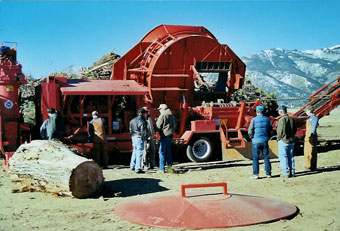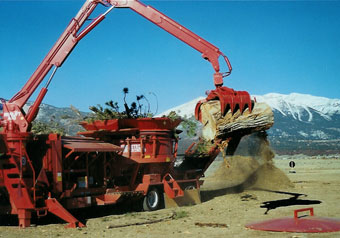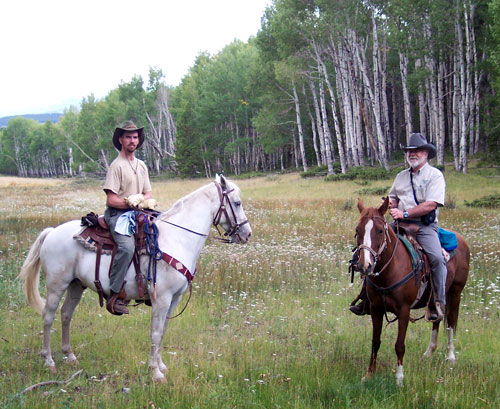Early Story of Colorado Firecamp
(written in the Spring of 2004)
prevention leads to mitigation
Colorado Firecamp began, as many adventures do, with a simple
conversation. The two people involved were a U.S. Forest Service public
information officer and a volunteer firefighter. It was mid-July of 2002,
during Colorado's worst wildfire season.
Ann Ewing wears many hats - PIO among them - at the Salida
Ranger District office. Kent Maxwell serves as a captain with the Chaffee
County Fire Protection District.

Kent Maxwell—during a 2004 'staff ride' with 3 of his rookie volunteer
firefighters to a tenth-acre, lightning strike fire on the ridge above
Maysville.
Kent had stopped by to pick up some prevention posters (one
had the tagline: “Think you can't go camping without a campfire...”)
to distribute around the Poncha Springs station #4 response area.
Ann mentioned that people were generally complying with
the fire bans on public lands - thanks in part to the media attention
given to the Hayman, Iron Mountain and Missionary Ridge fires. The ranger
district had not issued any fire violations over the 4th of July weekend.
The fire district had similiar results from the engine crews working severity
patrols.
Smoke has a way of getting people's attention. Plenty of
smoke had drifted into the valley, with plumes visible from fires 50 miles
away viewed as all too close to home. By this time in the fire season,
landowners - who had ignored years of Firewise advice - were scared enough
to start clearing some defensible space around their houses and summer
cabins.
Kent had heard from several people about the difficulty
of getting rid of the slash being generated. Folks couldn't burn what
they had cut because of the fire bans. Hauling it off was difficult. Burying
it in the landfill didn't make sense. There was just so much slash.
Ann told Kent, “The person you really should talk
with is Paul.”
mitigation leads to training
Paul Janzen is the district forester serving Chaffee and
Lake counties for the Colorado State Forest Service. Paul is the ‘idea
man’ behind several of Kent's efforts.
The CSFS office in Salida owns a Vermeer wood chipper that
can be towed behind a pick-up truck and handle logs up to 12 inches diameter.
It works well for smaller thinning projects but is easily out-sized by
agressive mitigation. A chipper that size is especially un-suited to the
massive piles that accumulate before thought is given to slash disposal.
Paul said a ‘tub grinder’ was the machine really
needed for the job.

Kent had no idea just what a grinder was, tub or otherwise.
But before long, it became an obsession. Hundreds of e-mails followed,
and four different Vermeer and Morbark grinders came to the county that
fall.
During the summer of 2003, the fire district was awarded
a $20,000 National Fire Plan Community Assistance grant for a 30-day tub
grinder project. A second grant followed in 2004 for $29,700. In addition,
the district signed a 5-year cooperative agreement with the Bureau of
Land Management for continued work in ‘bio-mass utilization.’

Meanwhile, as summer turned to fall of 2002, Paul and Kent
kept talking. Mostly it was the incessant talk of tub grinders - that
is, whenever they could talk, because Paul was often away fighting the
big wildfires in the state and region.
Paul serves as a safety officer on a type 2 incident management
team. Gradually, the discussions shifted to the shortage of trained firefighters
‘ready, willing and able’ to fight all these fires. The Pueblo
fire zone dispatch (which handled the Hayman and Iron Mountain fires)
had over 1,500 unfilled resource requests from incidents, because the
properly trained and qualified people were not available.

Kent (left) and Paul
Janzen on an August, 2004 field trip to check fire mitigation in the
Maysville/North Fork area with Sam Schroeder (photographer.)
Soon, Kent was asking if a new firefighter school could
be started in the county. How hard could it be?
Paul told Kent, “The person you really should talk
with is Wendy.”
training leads to Wendy
Wendy Fischer coordinates the Colorado Wildfire Academy
and Great Plains Wildfire College. Her name is synonymous with wildfire
training in the state. She also happens to be about the nicest, most approachable
person. Invariably, as Kent talked to pretty much whomever would listen
to this idea of a new school, the first response was, “Well, have
you talked to Wendy?”
Well, talk we did. Eventually it all led to the formation
of Colorado Firecamp and a long process to sign a ‘memorandum of
understanding’ with the Rocky Mountain Coordinating Group. And,
from there it continues to actually training firefighters.
What comes next? We're not exactly sure.
|
Credit where Credit is Due
other people who helped us get started
-
Dick and Enid Bauer — Kent's
parents own the Ponderosa Lodge. Without their support and willingness
to provide a home for Colorado Firecamp, none of this would
be possible.
-
Pete DeChant and Joel Kemm—The
former Salida Fire Chief and USFS Mountain Zone FMO, respectively.
Both gave many months of advice and encouragement while the
MOU process dragged on.
-
Charlie Medina and Sam Schroeder —Charlie
is the USFS Salida District Ranger, and Sam (whose title we
never quite figured out) is the guy that gets things done for
the district. Their support and guidance has been invaluable.
-
Ed Skerjanic—FMO for the
BLM Royal Gorge field office. Ed's enthusiastic response to
an early e-mail convinced us that we had an idea that could
work.
-
Tracy Beaudin and Quinn MacLeod —
The former and current Pueblo Zone training reps. Like most
people who do this stuff, Tracy and Quinn have taken on training
as a collateral duty. Still, they found time to help us out,
too.
-
Andy Parker — BLM Assistant
FMO for Colorado. Andy objected to the Rocky Mountain Area signing
the MOU for Colorado Firecamp, on grounds that when training
isn't done right, it jeopardizes firefighter safety. While we
disagreed about the MOU, his influence is felt in our passion
for firefighter safety.
-
Kim Bang—Rocky Mountain
Area training representative. The NWCG training system is not
perfect. Kim's common sense approach helps resolve issues where
the pieces don't quite fit.
-
Jim Strain —FMO for the
state of South Dakota and former Region 2 training chair. Jim
was the shepherd who got the MOU through the process. His feedback
on possible names is why we chose ‘Colorado Firecamp’
as the name of this school.
|
|